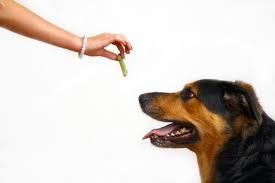 Boy do I get a lot of flack for thinking this way.
Boy do I get a lot of flack for thinking this way.
Whenever I go on message boards or forums to contribute to the dog training discussion I often get slammed by other ‘dog professionals’ and ‘trainers’ who tell me what a monster I am for using corrections in dog training.
If you haven’t noticed, over the past decade or two there has been a huge movement in the dog training industry. They call it ‘purely positive’ or ‘treat training’ or a whole variety of other names.
The idea behind it is that it is more humane to use treats and NEVER corrections (tug on leash, spray bottle, e-collar, etc.) in training your dog. They’ll tell you of the studies done at Universities and of the brilliant trainers who lead this movement and will basically try to bully you if you feel otherwise.
The idea sounds great….in theory.
In practice, though, this style of training violates nearly all aspects of proper training and is arguably the LEAST humane way to train a dog. Let me tell you why:
1- It violates how any creature on earth learns! This style of training calls for rewarding positive behavior and either re-directing or even ignoring bad behavior. For example, with a dog that jumps on you it is taught to simply turn your back and ignore the dog. The idea is that the dog will realize he doesn’t get attention from jumping and he’ll stop. I’m sure that has worked with some dogs but…what about dogs that just like jumping purely for jumping sake? What about a dog that doesn’t care whether or not he’s getting attention he just likes to put his muddy paws on you? Ignoring bad behavior is a silly idea that rarely works.
The idea of redirection, however, is a good idea but flawed if it is used alone. For example, I recently saw a Youtube video where a trainer was teaching a dog to not steal food off the table by encouraging the dog to come get food from her instead. Essentially she was redirecting the dog’s attention. Good idea, right? She thought so but a simple understanding of dog behavior will tell you why this is such a flawed idea. See it from the dog’s point of view, “Okay, there is a hot dog on the table but she’s holding a hot dog over there. Well, she’s going to praise me and it’s easier to get it from her so I’ll do that.” What happens, though, when the owner isn’t around? That Christmas ham is just sitting there juicy and inviting while the owner is polishing the silver in the dining room. The owner never actually taught the dog that IT WAS WRONG to get on the table or counter, she merely taught the dog that it was MORE RIGHT to get food from her. When food from her isn’t an option then food on the counter is looking pretty good.
Pretty soon the dog is four paws up on the counter and Christmas is ruined for everyone.
2- ‘Purely Positive’ styles of dog training lead to more drugs. Okay, calm down for a second. I’m not about to tell you how to teach your dog to ‘Just Say No’ but the fact remains that drug use is drastically up in dogs over the last decade. The drugs I’m talking about are the mood altering types of drugs like prozac and others.
I am personally a believer in using drugs as a very last resort when it comes to dog behavior. The side effects to drugs typically aren’t kind and they aren’t humane for the most part. Lethargy, weight gain, and other side effects are common when you dope a dog up.
You may be asking what the connection is between drugs and purely positive training? Simple. When you aren’t willing to use proper corrections with a dog you are incredibly limited by what you can do. For example, when you aren’t willing to correct the dog because he’s being aggressive, chewing your shoes, overly hyper, etc. your only other option is to try to use treats over a LONG period of time to try to recondition the dog to doing other things. I’ve got news for you, most dogs with aggression or destruction problems care more about that then they do about a treat.
So here you’ve got an aggressive dog whose owner is trying to bribe it into not being aggressive with treats. Fast forward a few months and now you’ve got a dog who is still aggressive and still doesn’t care about treats. That’s where the helpful treat trainer says, “Time to get your dog on medication.” Don’t get me wrong, there are dogs that need medication, but not many. I can’t tell you how many dogs I’ve rescued from medication that other trainers recommended. All I did was train firm when it came to completely unacceptable behaviors. So instead of dealing with months or years of bad behavior and resorting to chemically altering the state of mind of the animal we fixed and/or improved the problem in a short period of time.
To me it is far more humane to use firm but fair corrections to deal with a behavior problem than it is to run to the medicine cabinet when Sparky decides he needs to eat the mail man.
3- ‘Purely Positive’ styles of dog training lead to more dogs in shelters and rescues. Okay, I know I’ll get raked across the coals for this one but I’m going to say it anyway.
Using a purely positive style of training takes a LONG time to be effective IF it’s going to even be effective at all. For example, I’ve had numerous clients who are at their wit’s end because they’ve spent months trying to teach their dog to walk on a loose leash. Their previous trainer told them that whenever the dog pulled they should stop, allow the dog to calm down, and then continue the walk. Like shampoo, repeat as necessary. Guess what? They never got anywhere with their walks. The dog had such a desire to pull, didn’t care about treats while in the great outdoors so the owner was left to suffer for months trying to fix an easy problem.
In every one of these cases we can use appropriate and fair corrections and have their dog walking just fine within minutes.
Now, in this previous case I was talking about leash walking. But there are far more serious cases of aggression, destruction, anxiety, etc. that treat trainers attempt to fix with treat conditioning methods. People are busy nowadays so, it may not be right, but most dog owners don’t have two hours a day over the course of months or years in order to fix a problem. So where do those problems often land? At the shelter or in many cases on the euthanasia table at the veterinarian’s office.
There are cases where dogs need to be put down for behavior issues. There are cases where someone legitimately can’t handle a dog and needs to re-home it. The brutal reality is, though, that many people have been convinced by purely positive trainers that they are going to have to put in so much work to fix it and they just can’t take the prospect of all that work for an outcome that is anything but guaranteed.
You take the same dog owner, same dog, and show them how proper motivation and proper correction can solve their problems in a fraction of the time and now you don’t have a dog being put down or sent off ‘to live at a farm where he can chase bunnies all day’.
To me it is far more humane to use corrections to fix behavior problems then to face the possible alternative.
Okay, I know I’ve been bashing purely positive methods quite a bit. The truth is that I think the movement has done so much to set back dog ownership that I’m not a fan. That’s not to say, though, that there aren’t redeeming qualities. I believe that motivation should be a primary factor in training your dog. I do happen to think you should be using FAR more physical and verbal praise than treats, though. I mean, I’d rather have my dog be obedient to me than to a piece of liver. But I do believe that any humane training program must find balance. Yes, you need corrections. But not ONLY corrections. You need to balance it with praise, fun, reward, etc. Your dog should enjoy being obedient to you and that is very doable when you approach training from a balanced standpoint.
If corrections are used improperly then they are easily the least humane way to train a dog. When they are used properly and in balance, though, this is a far more humane way to train a dog than ‘purely positive’ or ‘treat trainer’ methods.








7 Responses to “Why Treat Training Is The Least Humane Way To Train A Dog”
Agreed! Agreed! Agreed! Excellent points…and my experience supports them. My most obedient GSD’s were trained with appropriate physical corrections - my worst, with treats. Unfortunately I listened to “positive approach” experts who told me to ditch the corrections. The treat bribery method revealed to my last GSD my softness and lack of leadership. The dog walked all over me … disobedience escalated into aggression. It was a mess. After 16 unhappy months, she went back to the breeder. (Of course a few other issues were at play too, but I believe the outcome would have been different had we used physical corrections.)
We now have a new pup and are training with physical and verbal praise. She’s learning fast and is a happy dream instead of a dreadful nightmare. I did swing a little too far though with the treats. After watching your crate training video, I should have used your method. I was leary of the treats and have to remind myself they are appropriate at times.
Love the site!
Thanks! Glad to have you as a reader.
I enjoyed reading the article, thanks for presenting your thoughts clearly. A different point of view is always good! I’ve had great success with positive reinforcement (using food and other environmental reinforcers) and have been very happy to give away physical corrections. My understanding is that the style of training you choose is only as good as the trainer doing the training. I would love to hear your comments on this thought. Thank you again for a good article.
I do think that a style is either enhanced or detracted from based on the skill of the practitioner. So in that sense, I’ll agree. But I also believe that philosophically there are good, better, and best techniques for training dogs. For example, if I want to hammer in a nail I can use a hammer or the broad side of a can of 2×4 piece of wood. Both may be able to get the job done, but one is better. I can lose weight by eating healthy or I can loose weight by eating healthy and exercising better. Out of the options, one is better.
I feel the same about positive only training style vs. a more stabilized approach. You can get the job done i.e. train the dog either way. But a solid practitioner of stabilized training techniques will get further than a solid practitioner of positive only techniques every time if we’re to compare their level of proficiency as equal within their style.
The reason being is that a stabilized approach is more complete and speaks to the dog better and compensates for drives, desires, etc.
I do believe that a very good practitioner of positive only can train circles around a bad trainer using corrections in their training but if you match up apples to apples I would never feel comfortable putting my name on the results achieved through positive only training.
Exactly, So interesting to read and especially about the “steel food from the table”. I Think that correction and rewarding belong together.
If you say “no” when she does wrong, she understands why. (If you do it right!) You get no less cooperation with the dog for it. As long as the dog understands and gets a reward too (when she behaves).
I tell my dog when she do something wrong, but at the same time I reward her when she do something good. It works together!
//Dog lover
Okay-so I’ve been treat-training my new SIberian Pup with decent success, BUT, as is the case with Siberians, she often becomes distracted and the treats lose their power quickly when she directs her attention elsewhere. Big problem number one: puppy chewing. With my Chiweenie (8lbs), it wasn’t such a big deal because, well, her little mouth (at 2 lbs) was only so powerful and she responded well to verbal cues. But with Justina, wow-that’s a big puppy mouth and those little razor sharp teeth are set in far more powerful jaws. Verbal isn’t working, stop it (loud reprimand) isn’t working, turning away isn’t working. What type of (immediate) correction technique can I begin to implement now as I’m awaiting our first session? I want to nip (bad pun) this in the bud and make it stop, NOW. It’s painful, it’s embarrassing and, it’s really, really bad for small children. Thanks, Ty, for an outstanding website. I’m truly looking forward to getting started in training next week!
You are quite welcome!
I would start out by having the dog on a leash at all times for now. Use the leash for small corrections rather than simply turning away from jumps and bites.